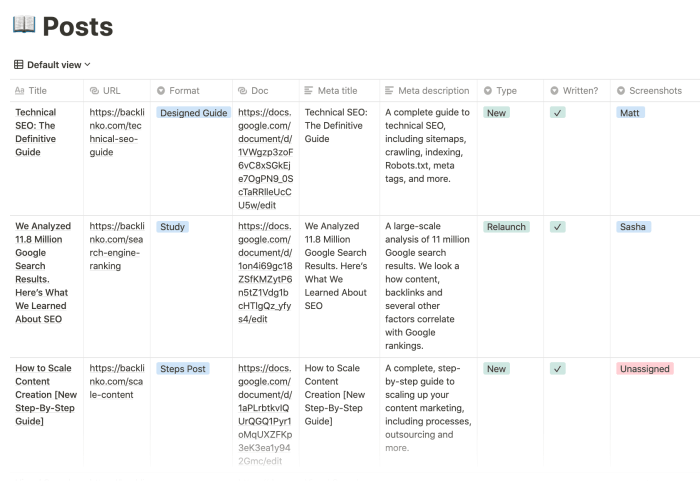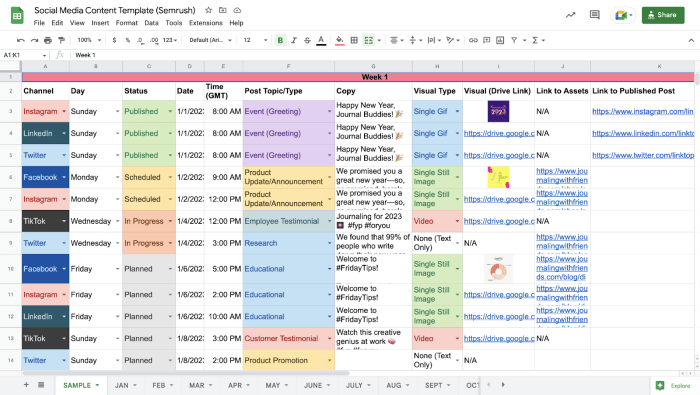Creating a Content Marketing Calendar is the key to unlocking your business’s potential in the digital world. Dive into this essential guide for strategic planning and organization to boost your brand’s success.
Learn how to craft a winning content strategy, engage your audience, and stay ahead of the competition with a well-structured calendar that ensures consistency and efficiency.
Importance of a Content Marketing Calendar

Having a content marketing calendar is crucial for businesses looking to effectively plan and execute their content strategy. It provides a structured approach to content creation, ensuring that the right content is delivered to the right audience at the right time.
Organizing Content Strategy
A content calendar helps in planning and organizing content strategy by providing a clear roadmap of the topics, themes, and types of content to be created. It allows businesses to align their content with their overall marketing goals and objectives, ensuring consistency and relevance.
Benefits of Using a Content Calendar
- Consistency: A content calendar helps businesses maintain a consistent presence across different channels, increasing brand visibility and engagement.
- Efficiency: By planning content in advance, businesses can save time and resources, ensuring that content creation is done in a timely manner without last-minute rush.
- Resource Allocation: With a content calendar, businesses can allocate resources effectively, ensuring that the right resources are available for content creation and distribution.
- Analytics: By tracking and analyzing the performance of content scheduled in the calendar, businesses can make data-driven decisions to optimize their content strategy for better results.
Components of a Content Marketing Calendar: Creating A Content Marketing Calendar

To create an effective content marketing calendar, it is crucial to include key elements that will help in organizing and planning your content strategy. By incorporating these components, you can ensure consistency, relevance, and alignment with your overall marketing goals.
Content Types Categorization
When structuring your content marketing calendar, it is essential to categorize different types of content to maintain variety and engagement. Consider categorizing content based on format (blogs, videos, infographics), topics (product updates, industry news, how-to guides), and audience segments (new leads, existing customers, influencers). This approach will help you balance your content mix and cater to the diverse needs of your target audience.
- Blog Posts: Educational articles, thought leadership pieces, and industry insights.
- Social Media Posts: Engaging updates, promotional content, and user-generated content.
- Email Campaigns: Newsletters, product announcements, and personalized recommendations.
- Video Content: Tutorials, product demos, behind-the-scenes footage, and customer testimonials.
Setting Goals and Timelines
Incorporating clear goals and timelines into your content marketing calendar is essential for driving results and measuring success. Define specific objectives for each piece of content, whether it is to increase brand awareness, generate leads, drive website traffic, or boost sales. Establish realistic timelines for content creation, publication, and distribution to ensure a consistent flow of engaging material across your channels.
By setting measurable goals and deadlines, you can track the performance of your content marketing efforts and make data-driven decisions to optimize your strategy.
Creating a Content Marketing Calendar
Creating a content marketing calendar is crucial for planning and organizing your content strategy effectively. Here are some steps to help you create a content marketing calendar that works for your team.
Step-by-Step Guide
- Start by outlining your content goals and objectives. Determine what you want to achieve with your content marketing efforts.
- Identify your target audience and conduct research to understand their needs and preferences.
- Brainstorm content ideas based on your goals and audience research. Consider different types of content such as blog posts, videos, infographics, etc.
- Set a realistic publishing schedule that aligns with your goals and resources. Decide how often you will publish and on which platforms.
- Use a content calendar template or software to organize your content ideas, topics, deadlines, and publishing dates. Tools like Google Calendar, Trello, or CoSchedule can be helpful.
- Collaborate with team members to assign tasks, track progress, and ensure consistency in content creation. Communication is key to a successful content calendar.
- Regularly review and update your content calendar to reflect any changes in your strategy, goals, or audience feedback.
Content Planning and Scheduling
When it comes to content planning and scheduling, it’s important to have a strategic approach to ensure that your content calendar aligns with your goals and resonates with your target audience. By carefully planning topics and themes and scheduling content effectively, you can maximize engagement and drive results for your brand.
Planning Content Topics and Themes
Planning content topics and themes involves understanding your audience’s needs, interests, and pain points. Conducting thorough research and analysis can help you identify trending topics, s, and industry insights that can inform your content strategy. By creating a content roadmap that Artikels key themes and topics for each month or quarter, you can ensure that your content remains relevant and timely.
- Conduct research to identify relevant topics and themes
- Review industry trends and insights to inform your content strategy
- Consider seasonality and holidays when planning content themes
- Create a content calendar that Artikels key topics for each month or quarter
Scheduling Content Effectively
Scheduling content effectively involves considering your audience’s behavior and preferences to determine the best times to publish and promote your content. By analyzing data from past campaigns and leveraging analytics tools, you can identify peak engagement times and optimize your content schedule accordingly. Additionally, segmenting your audience based on demographics and psychographics can help you tailor content delivery to meet their specific needs.
- Use analytics tools to identify peak engagement times
- Segment your audience based on demographics and psychographics
- Optimize your content schedule based on audience behavior and preferences
- Experiment with different publishing times to determine the most effective schedule
Maintaining Flexibility in the Calendar, Creating a Content Marketing Calendar
While it’s important to have a structured content calendar, it’s also essential to maintain flexibility to accommodate timely adjustments and capitalize on emerging trends or opportunities. By regularly reviewing and updating your content calendar, you can ensure that your content remains relevant and resonates with your audience. Additionally, leaving room for ad-hoc content or last-minute changes can help you stay agile and responsive to market dynamics.
- Regularly review and update your content calendar to stay relevant
- Leave room for ad-hoc content or last-minute adjustments
- Monitor industry trends and adjust your content strategy accordingly
- Stay agile and responsive to market dynamics by maintaining flexibility in your calendar